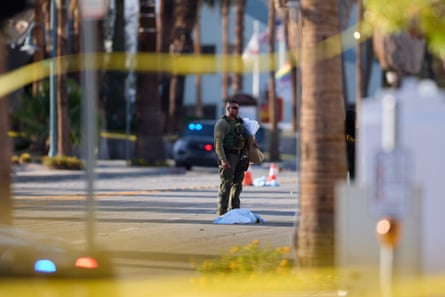Experts say an online ecosystem that allows lone actors to latch on to fringe viewpoints is bolstering violent extremism in the US, following an attack over the weekend on a fertility clinic in Palm Springs, California.
Investigators are combing through the writings of a 25-year-old man killed in a large explosion outside the American Reproductive Centers, an IVF facility, that was heavily damaged in what they have described as an “intentional act of terrorism”. The suspect in the bombing, Guy Edward Bartkus, left behind writings that appear to hold fringe theories of “antinatalism” and nihilism, ideologies that oppose procreation and have a general sense of the meaninglessness of life.
Officials are still looking into the beliefs behind the attack and if Bartkus can be linked to a website bolstering those viewpoints. But in the meantime, experts say the nihilistic worldview the suspect possibly adhered to is part of a growing trend of people finding smaller, niche ideologies rather than movements linked to jihadist violence that have drawn followers for decades.
Brian Levin, the founding director of the Center for the Study of Hate and Extremism and a professor emeritus at Cal State San Bernardino, described antinatalism as one of the more obscure theories he has tracked. The concept generally circles around the notion that reproduction is cruel and that more children should not be brought into a harsh world. A manifesto published online before the bombing included a hope to sterilize the planet “of the disease of life”, although it has not yet been linked to Bartkus.

But rather than the motivations behind antinatalism specifically, Levin said online spaces now allow those with lone wolf mentalities to use “what they find in the online space as kind of a hand in glove for their own idiosyncratic perspectives”.
“I think that there are a couple of things that are often left out, the role that psychological distress plays, as well as how the internet can aid and abet antisocial, aggressive or suicidal behaviors,” Levin said. “When one’s grievances, paranoia, despair are amplified and then twisted into an anger that is part of a continuum, this rabbit hole particularly for these unstable folks is very easy for people to go down.”
The extremely online nature of modern life, Levin said, has only exacerbated the ability of lone actors to find motivation and validation, when in the past those ideas may have existed in their own silo, without an on-ramp to violence.
“[Now] the anger and grievance can find a philosophical home in an online community, with a skill acquisition component, which can make people even more violent than they were before,” Levin said. “When psychological self-destruction has its own community, online space, and identification of legitimate targets for this aggression, that’s what you get.”
Javed Ali, an associate professor at the University of Michigan and a former senior counterterrorism official for the US government, agreed. He said attacks like the one in Palm Springs were part of a growing pattern of lone wolf tactics, and that investigators were faced with the difficult task of homing in on obscure individual motivations.
Ali, who spent decades working for the FBI and Department of Homeland Security, among other agencies, said there was no single profile or dominant ideology investigators can look to in hopes of stopping violent attacks. That can be difficult for officials, who in the past were more accustomed to looking at links to trends in jihadist ideologies and now have to wrangle “this whole diverse spectrum of extremist beliefs out there”.
Often, that can mean a potential attacker isn’t on law enforcement’s radar – until they are. He pointed to an attempted car bombing in Times Square in 2010. The wannabe attacker, Faisal Shahzad, built a homemade explosive device, placed it inside his SUV and drove the bomb to New York City, where it failed to detonate.
“He put a car bomb together in his garage, completely not drawing the attention of anybody and drove 30 or 40 miles to New York,” Ali said, adding he was often shocked people like Shahzad were able to put together “really sophisticated” devices by themselves.

“A lot of times those people are previously not subjects of FBI investigations, they move pretty seamlessly in this world from radicalization to mobilization and they’re able to conceal or not reveal those steps that probably would get you on the radar screen,” he said.
“It’s so hard to stop them,” Ali added. “It’s so hard to identify them in the first place because things are very fuzzy.”
Levin went on to say while Americans are largely afforded great freedoms under the first amendment – with even sociopathic viewpoints largely protected – the state of the internet and social media had left a vacuum into which those in psychological distress can fall into. Safeguards like notifications on search browsers alerting people to help and support could be a vehicle to help counter that black hole.
“You’re not going to be able to eliminate this,” he said. “But what we can do is offer off-ramps and help that can hopefully be a choice for people who are otherwise careening without any speed bumps towards a violent or suicidal demise.”
